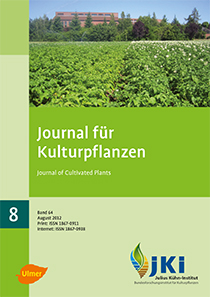Contributions of plant breeding to climate protection and to the adaptation to climate change
DOI:
https://doi.org/10.5073/JfK.2012.08.02Keywords:
Climate change, rye, sorghum, bioenergy, biomass productionAbstract
Plant breeding has the potential to meet the challenges of a changing climate in two ways. Firstly, plant breeding provides new varieties which offer better yield stability than previous ones under modified climate and weather conditions and, thus, make a substantial contribution to adapt agriculture to the climate change. Secondly, breeding varieties which have improved resource efficiency (e.g., with regard to the use of fertilisers), augmented yields per unit area, and suitability for use as renewable energy sources contributes to active climate protection by saving fossil energy resources. One strategy to improve crop plants for renewable energy production is to agronomically adapt scarcely used or novel crop plants with high biomass potential to local growing conditions. A second one is to adapt traditional crop plants to novel types of use and to dedicated cultivation systems.
In the present study, the genetic potentials of (i) sorghum and (ii) rye for biomass production were investigated. After sowing the trial at the end of June and under favourable growing conditions in northern Germany, Sorghum bicolor × S. bicolor-hybrids displayed a very high yield potential of total dry matter yield of 146,3 dt/ha, which was comparable to silage maize yields in that year. However, in a second experimental year, nippy and clammy weather during early growth led to considerably reduced total dry matter yields, showing up the need for further adaptation of sorghum via breeding.
Assessment of various rye forms for their biomass production ability revealed (1) high genetic variance reclaimable for breeding purposes and (2) promising total dry-matter yields. Several entries showed a combination of high population per se performance and significant heterotic increase. Hence, including specific accessions such as forage rye or non-adapted plant genetic resources in the breeding process should enable the development of high-performance energy hybrid rye varieties in the medium-term.
Taken together, the genetic biomass potential of the cropping system “rye – sorghum” seems to be high and may be predicted to exceed 300 dt/ha total dry matter under favourable growing conditions.
Downloads
Published
Issue
Section
License
The content of the journal is licensed under the Creative Commons Attribution 4.0 License. Any user is free to share and adapt (remix, transform, build upon) the content as long as the original publication is attributed (authors, title, year, journal, issue, pages).
The copyright of the published work remains with the authors. The authors grant the Journal of Cultivated Plants, the Julius Kühn-Institut and the OpenAgrar repository the non-exclusive right to distribute and exploit the work.







